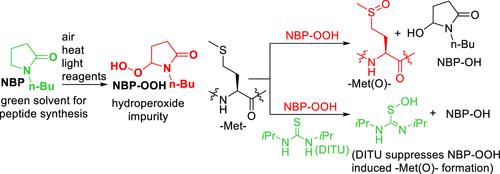当前位置:
X-MOL 学术
›
Org. Process Res. Dev.
›
论文详情
Our official English website, www.x-mol.net, welcomes your
feedback! (Note: you will need to create a separate account there.)
Advancing Sustainable Peptide Synthesis by Solvent Quality Control: Understanding and Mitigating Hydroperoxide in 1-Butyl-2-pyrrolidinone (NBP)
Organic Process Research & Development ( IF 3.1 ) Pub Date : 2024-07-25 , DOI: 10.1021/acs.oprd.4c00225 Jan Pawlas 1 , Tharwat Mohy El-Dine 2, 3 , Katharina von Bargen 1 , Christoph von Bargen 1 , Johan Nilsson 1 , Olivier Ludemann-Hombourger 2, 3 , Jon H. Rasmussen 1
Organic Process Research & Development ( IF 3.1 ) Pub Date : 2024-07-25 , DOI: 10.1021/acs.oprd.4c00225 Jan Pawlas 1 , Tharwat Mohy El-Dine 2, 3 , Katharina von Bargen 1 , Christoph von Bargen 1 , Johan Nilsson 1 , Olivier Ludemann-Hombourger 2, 3 , Jon H. Rasmussen 1
Affiliation

|
While numerous studies aimed at producing peptides in a sustainable manner have recently been reported, the impact of the quality of starting materials on sustainability in peptide synthesis has been less investigated. Here we report that NBP, a greener dipolar aprotic solvent suitable for use in SPPS, readily undergoes air oxidation to the corresponding hydroperoxide (NBP-OOH), which adversely affects oxidation-sensitive amino acids and peptides. Air, light, elevated temperatures, and common peptide synthesis reagents such as DIC accelerated the rate of NBP oxidation. LC-HRMS analyses revealed that air-induced NBP degradation proceeds via a different mechanism than the previously elucidated degradation of the closely related NMP while GC–MS of NBP containing NBP-OOH showed that standard GC-based analytical methods are unsuitable for NBP-OOH detection, warranting implementation of improved methods for NBP analyses. Assessment of NBP-OOH-induced Met, Trp, Cys, and Tyr breakdown revealed not only that NBP-OOH degrades all these oxidation-prone substrates, but it was also discovered that DITU, previously reported to suppress N-oxyl radical-induced peptide breakdown, constitutes an efficient suppressant of hydroperoxide-induced degradation. Studies on aerial oxidation of additional greener dipolar aprotic solvents DMSO and DMPU revealed that while the former is stable and does not cause oxidation, the latter is oxidized extensively upon air exposure and degrades oxidation-prone substrates to a significant extent. On the other hand, air bubbling of NBP, DMSO, and DMPU proved to have an unexpected positive effect on the stability of the α-amino-bound Fmoc group, a finding that may be leveraged to minimize premature Fmoc loss during peptide synthesis. Overall, our studies on understanding and mitigating hydroperoxide formation in greener solvents for peptide synthesis illustrate the importance of a thorough quality assessment of starting materials during the development of sustainable synthetic methods.
中文翻译:

通过溶剂质量控制推进可持续肽合成:了解和减少 1-丁基-2-吡咯烷酮 (NBP) 中的氢过氧化物
虽然最近报道了许多旨在以可持续方式生产肽的研究,但起始材料质量对肽合成可持续性的影响的研究较少。在此,我们报道 NBP 是一种适用于 SPPS 的绿色偶极非质子溶剂,很容易在空气中氧化成相应的氢过氧化物 (NBP-OOH),这会对氧化敏感的氨基酸和肽产生不利影响。空气、光、高温和常见的肽合成试剂(例如 DIC)会加速 NBP 的氧化速度。 LC-HRMS 分析表明,空气引起的 NBP 降解通过与之前阐明的密切相关的 NMP 降解不同的机制进行,而含有 NBP-OOH 的 NBP 的 GC-MS 表明,基于 GC 的标准分析方法不适合 NBP-OOH检测,保证实施改进的 NBP 分析方法。对 NBP-OOH 诱导的 Met、Trp、Cys 和 Tyr 分解的评估表明,NBP-OOH 不仅会降解所有这些易氧化的底物,而且还发现之前报道的 DITU 可以抑制N-氧自由基诱导的肽分解,构成氢过氧化物引起的降解的有效抑制剂。对其他绿色偶极非质子溶剂 DMSO 和 DMPU 的空气氧化研究表明,虽然前者稳定且不会引起氧化,但后者在空气暴露后会被广泛氧化,并在很大程度上降解易氧化的底物。另一方面,NBP、DMSO 和 DMPU 的空气鼓泡被证明对 α-氨基结合的 Fmoc 基团的稳定性具有意想不到的积极影响,这一发现可用于最大限度地减少肽合成过程中 Fmoc 的过早损失。 总体而言,我们关于了解和减少肽合成绿色溶剂中氢过氧化物形成的研究说明了在可持续合成方法开发过程中对起始材料进行彻底质量评估的重要性。
更新日期:2024-07-25
中文翻译:

通过溶剂质量控制推进可持续肽合成:了解和减少 1-丁基-2-吡咯烷酮 (NBP) 中的氢过氧化物
虽然最近报道了许多旨在以可持续方式生产肽的研究,但起始材料质量对肽合成可持续性的影响的研究较少。在此,我们报道 NBP 是一种适用于 SPPS 的绿色偶极非质子溶剂,很容易在空气中氧化成相应的氢过氧化物 (NBP-OOH),这会对氧化敏感的氨基酸和肽产生不利影响。空气、光、高温和常见的肽合成试剂(例如 DIC)会加速 NBP 的氧化速度。 LC-HRMS 分析表明,空气引起的 NBP 降解通过与之前阐明的密切相关的 NMP 降解不同的机制进行,而含有 NBP-OOH 的 NBP 的 GC-MS 表明,基于 GC 的标准分析方法不适合 NBP-OOH检测,保证实施改进的 NBP 分析方法。对 NBP-OOH 诱导的 Met、Trp、Cys 和 Tyr 分解的评估表明,NBP-OOH 不仅会降解所有这些易氧化的底物,而且还发现之前报道的 DITU 可以抑制N-氧自由基诱导的肽分解,构成氢过氧化物引起的降解的有效抑制剂。对其他绿色偶极非质子溶剂 DMSO 和 DMPU 的空气氧化研究表明,虽然前者稳定且不会引起氧化,但后者在空气暴露后会被广泛氧化,并在很大程度上降解易氧化的底物。另一方面,NBP、DMSO 和 DMPU 的空气鼓泡被证明对 α-氨基结合的 Fmoc 基团的稳定性具有意想不到的积极影响,这一发现可用于最大限度地减少肽合成过程中 Fmoc 的过早损失。 总体而言,我们关于了解和减少肽合成绿色溶剂中氢过氧化物形成的研究说明了在可持续合成方法开发过程中对起始材料进行彻底质量评估的重要性。











































 京公网安备 11010802027423号
京公网安备 11010802027423号